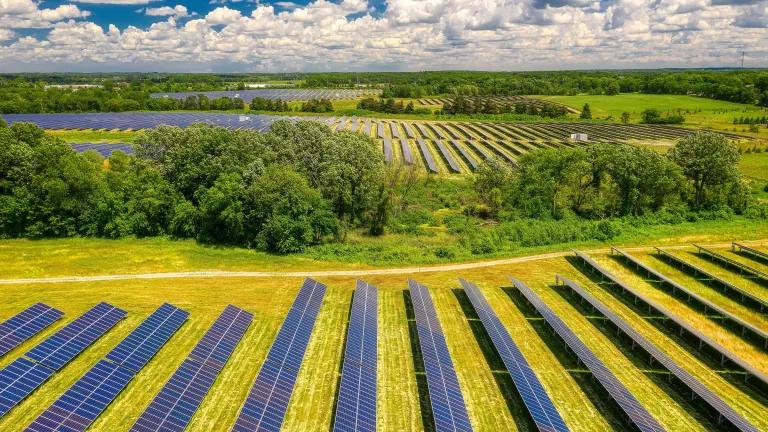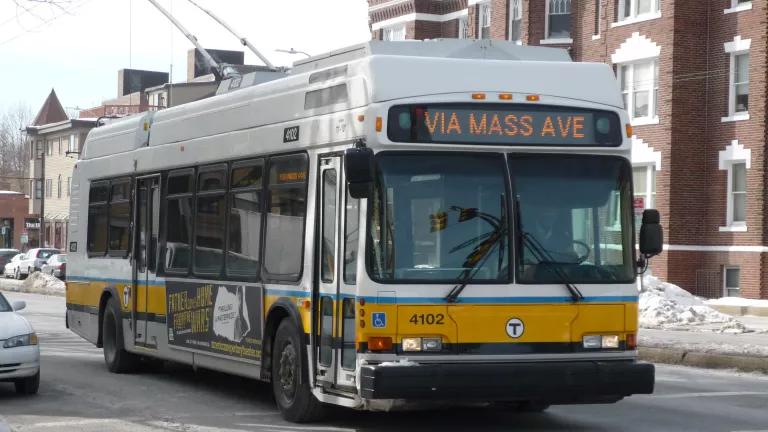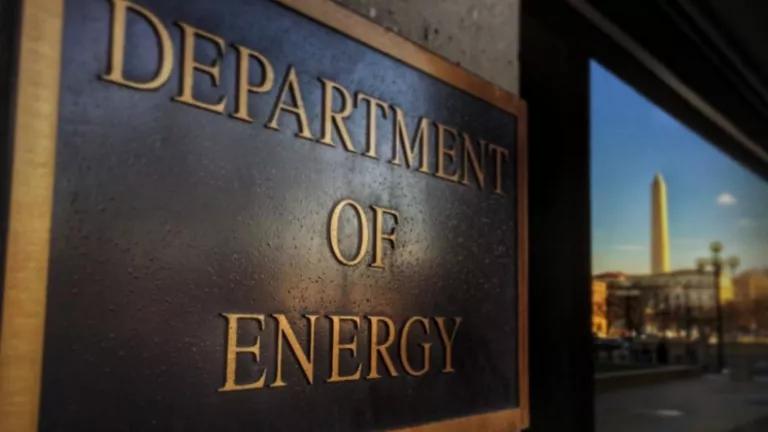Year in Review for DOE Clean Energy Innovation and Outlooks for 2024
Congress must protect and extend clean energy innovation policies to advance an equitable, prosperous, and just energy transition.

Building blocks for a clean energy transition
Parradee Kietsirikul
This Blog is part of NRDC’s Year-End Series Reviewing 2023 Climate & Clean Energy Developments.
Clean energy innovation remains an essential pillar of the energy transition.
Clean energy innovation remains an essential pillar of the clean energy transition. In 2023, we witnessed numerous exciting developments out of the U.S. Department of Energy (DOE)—all while partisan fighting in Congress threatened to derail the ability of DOE to continue to take actions necessary to achieve a net-zero emissions economy by 2050, to create good-paying jobs right here at home, and to save households and businesses money on their energy bills.
DOE Appropriations: Year in review
Despite DOE’s important role and impressive track record in spurring the development and commercialization of clean energy technologies, the department has been subjected to budgetary uncertainty over the years. 2023 was no different.
The year began with Republicans in the House vowing to claw back vital climate investments passed in the previous Congress. Republicans doubled down on their threat with the release of the partisan House Energy and Water Development (E&W) Fiscal Year 2023 appropriations bill that not only rescinds popular clean energy economic provisions but also guts the essential programs at DOE that drive energy innovation. The bill passed the House chamber along party lines in October.
The House E&W bill contains significant funding cuts to DOE’s clean energy research, development, demonstration, and deployment (RDD&D) portfolio. It decreases DOE’s Office of Energy Efficiency and Renewable Energy (EERE) budget by an astonishing 42% relative to Fiscal Year 2023 (FY2023) EERE funding levels (nearly $1.5 billion) and compounds what is already profoundly insufficient funding for such critical programs as the Building Technologies Office.
DOE’s Office of Energy Efficiency and Renewable Energy is an engine of the clean energy transition.
EERE has delivered significant economic and health benefits to U.S. households and businesses and is an engine of the clean energy transition as the single-largest investor in clean energy technology development in the Federal Government. The office is integral in developing the crucial sectors to secure our nation’s energy future—such as sustainable transportation, clean and efficient buildings, clean power, and clean industries. In addition, several independent impact evaluation studies have assessed one-third of EERE’s R&D portfolio to date and found that $12 billion in total investment has generated more than $388 billion in net economic benefits to the United States, with an attractive overall annual rate of return of more than 27%. In other words, investments in EERE pay for themselves many times over in terms of boosting our economy.
The bill does not stop at eroding EERE’s future success; it also rescinds funding from Inflation Reduction Act (IRA) climate programs that will hinder our nation’s progress to respond to the climate crisis and advance clean energy technologies. For example, the House E&W bill includes provisions to cancel pivotal IRA building sector funding and revoke $15 billion in loan authority made available to the DOE Loan Program Office (LPO).
Troubling legislative riders similarly plague the House bill, including attempts to block the Federal Government’s ability to reverse historical discrimination, particularly around land, water, and the environment. Other included riders will defund the Justice40 Initiative and block frontline communities from accessing clean energy, energy efficiency, and transit resources. Some of the included riders also rescind pro-consumer IRA provisions, such as the $4.5 billion for rebates for new electric appliances or the installation of home electrification projects. The myriad of poisonous riders is alarming because they undermine and stymie an equitable and just energy transition.
In contrast, the Senate E&W bill calls for a 7% increase in EERE funding relative to FY2023. While this is insufficient to catalyze the clean energy transition, the Senate bill is a notable bipartisan effort that protects the investments in clean energy innovation to respond to the climate crisis. It is also worth noting that the Senate bill does not cut IRA provisions or contain new troubling riders.
This year, Congress failed to present any of the 12 appropriations bills that set discretionary federal agency spending levels to the President. To avoid a federal government shutdown, Congress passed its latest short-term budget measure to allow lawmakers time to reach a consensus on a full-year budget. The newest measure stretches through the holiday season, with E&W funding expiring on January 19, 2024, which means the House and Senate will need to resume negotiations shortly into the new year.
DOE Appropriations: What’s ahead
Even though the Fiscal Year 2024 (FY24) appropriation process still needs to be completed, planning for Fiscal Year 2025 (FY25) appropriations must begin in the new year and will depend heavily on the results of FY24 negotiations. As mentioned, the House and Senate E&W bills are vastly different, thus ensuring cross-chamber negotiations will prove challenging to move Congress beyond the FY24 impasse.
Congress must focus funding to maximize climate emissions reductions.
However, for FY25 and appropriation seasons beyond, in order to help reach our midcentury climate objectives, it will not only be necessary for DOE to be robustly funded but also for appropriators to direct funding in a net-zero orientation to move the emissions needle significantly. Nowhere is this as evident as in the industrial sector, for which few decarbonization solutions are readily available—we simply don’t yet have the technologies available to achieve deep emissions reductions in many industrial sub-sectors—so industrial decarbonization RDD&D is essential. But along with the other end-use sectors (i.e., vehicles and buildings), industrial sector RDD&D has historically been underfunded. So, while DOE’s entire clean energy innovation budget—particularly EERE’s—needs a meaningful boost, Congress must also adjust and focus the department’s funding to maximize climate emissions reductions.
In 2024 and beyond, NRDC will continue to strongly advocate for robust and sustained annual appropriations for clean energy innovation and better orientation towards the net-zero GHG goal by 2050 to ensure a sustainable innovation ecosystem and accelerate climate solutions at the necessary speed to achieve our climate goals.
Clean Energy Innovation Developments: Year in review
This year, DOE marked many exciting developments in clean energy innovation, particularly in the “demonstration and deployment” stages of the RDD&D lifecycle, much of which is housed under the new Under Secretary for Infrastructure and funded by the IRA and/or the Bipartisan Infrastructure Law (BIL). For example, in October 2023, the world received its first glimpse of the DOE’s flagship hydrogen hubs (H2Hubs) program that will set the tone for the nascent U.S. clean hydrogen market. While the seven selected H2Hubs represent a mixed bag of technologies showing differing levels of promise, NRDC remains pleased to see funding seemingly targeting hydrogen deployment in hard-to-electrify end-uses like steel and aviation. NRDC has also remained closely engaged in the development of H2Hubs to ensure that the hubs’ deployment maximizes the cleanest hydrogen projects targeted at the hardest-to-electrify applications, and advocate for increased transparency and community engagement in how DOE and states administer the hubs.
Other notable DOE accomplishments this year include:
- The publication of three reports focused on industrial decarbonization in the “Pathways to Commercial Liftoff” series. The reports are intended to provide a guide to pathways to decarbonization across eight industrial sectors of focus: chemicals, refining, iron & steel, food & beverage processing, pulp & paper, cement, aluminum, and glass. These sub-sectors are carbon intensive and have historically received less attention than, for example, the power and light-duty transportation sectors, such that the DOE industrial decarbonization reports constitute a key step towards a stronger RDD&D focus for developing and advancing industrial clean energy solutions.
- EERE’s release of an array of Funding Opportunity Announcements (FOA) to spur clean energy innovation, such as providing federal funding:
- to accelerate the capabilities of two thin-film photovoltaic (PV) technologies that will promote U.S. competitiveness in solar energy technologies manufacturing;
- to enable the innovations needed to advance U.S. wind systems, reduce the cost of electricity, and accelerate the deployment of wind power, which will help to decrease energy costs; and
- for technical assistance to help industrial facilities and other large energy users increase the adoption of clean onsite energy technologies.
Another development this year is that DOE selected the first two of four regional direct air capture (DAC) hubs this past summer, along with 19 smaller DAC projects supporting early-stage engineering and design work to accelerate the commercialization of a variety of DAC technologies to capture carbon dioxide (CO2) from the atmosphere and store it in geological formations or through the conversion into other products.
Time is of the essence for DOE to act.
Clean Energy Innovation Developments: What’s ahead
Implementation – Implementation – Implementation! Time is of the essence—not only because of the urgency of the climate crisis but also because many provisions within BIL and IRA have strict deadlines for when allotted funding will expire. For example, the DOE Loan Program Office's loan authority, funded through appropriations under the IRA, will lapse after September 30, 2026. The funding includes $290 billion of loan guarantee authority and approximately $8.6 billion in appropriations to support credit subsidies. For the many situations in which entirely spending down the funding before the deadlines is not feasible, extending the deadlines for many IRA and BIL provisions through Congressional action needs to be a top priority.
Furthermore, as the next election rapidly approaches, climate and energy policies could continue to experience political headwinds in 2024. As mentioned above, the Republican-led House sought to undermine several IRA and BIL energy-related provisions this year. Such threats could become even more prominent as we enter the election season. It’s unfortunate that IRA and BIL provisions have fallen victim to partisan threats of repeal when we’re currently witnessing how the same climate and clean energy policies deliver sweeping nonpartisan economic benefits. For example:
- Republican-led states are among IRA's and BIL's biggest recipients, making them among the top states for clean energy jobs;
- Two-thirds of the clean energy projects announced since the IRA became law are planned in Republican congressional districts; and
- Republicans control 9 of the top 10 congressional districts with existing or planned renewable energy manufacturing plants.
The above progress equates to clean energy economic dividends that Congress must protect and extend to all U.S. communities to advance an equitable, prosperous, and just energy transition. Thus, implementation is critical, and in 2024 and beyond, NRDC will continue to closely engage with DOE to defend its authority and funding for the clean energy innovation RDD&D lifecycle, including large-scale clean energy deployment—as provided in BIL and IRA—while pressing for implementation to maximize climate and community benefits.



